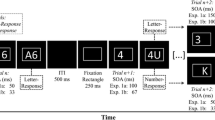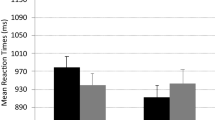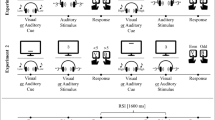Abstract
Switching between tasks associated with different requirements of stimulus selection may suffer interference from persisting attentional settings or processes of reconfiguration, possibly constituting a source of task switch costs (i.e., impaired performance in task switch trials compared to task repetition trials). To explore the processes involved in task switching with and without a switch in stimulus selection requirements, we administered a task-switching paradigm that involved task-unique sets of hierarchical (Navon) stimuli, preventing stimulus-related proactive interference (i.e., impaired responding to a stimulus that was previously processed in the context of a different task), and varied, between groups of participants, whether the target stimulus level (i.e., global vs. local) was held constant or varied between the tasks. Mixing target levels impaired performance overall and increased the task switch costs. Moreover, (within-task) global–local congruency effects were larger when target levels were mixed, particularly in task switch trials, suggesting relatively stronger stimulus processing according to the attentional set of the other task. In a second phase of the experimental session, the target level was changed persistently for either one or for both tasks, presumably evoking stimulus-related proactive interference. This change yielded large task switch costs and global–local congruency effects when it resulted in mixed target levels, but not when it resulted in a constant target level. These results are consistent with the notion that stimulus-related proactive interference is reduced by constant withdrawal of attention from the perceptual dimension of the interference-eliciting stimuli.



Similar content being viewed by others
Notes
Studies of global/local processing with varying target levels often use “divided attention tasks” in which the target level is to be identified by recognizing a target stimulus presented at that level. To avoid ambiguity, the stimulus presented on the other level is taken from a set of neutral symbols which are not assigned a response (i.e., neutral distractor, e.g., Lamb et al., 2000; Robertson, 1996; Yovel, Yovel, & Levy, 2001). With this procedure, all stimulus symbols (targets and distractors) are consistently presented at different levels depending on the target level condition. For instance, if the letter A serves as a possible target, it can only be presented on the global level in the global target condition and on the local level in the local target condition. Likewise, if it serves as a neutral distractor, it can only be presented on the local level in the global target condition and on the global level in the local target condition. Stimulus-evoked proactive interference in such studies is thus confined to previous occurrences of a target or distractor symbol on the alternative stimulus level than in the current trial (a global target A might interfere via associations with processing local target information, acquired during previous occurrences of local A in local target conditions). Although we know of no studies that addressed the question of the size of stimulus-evoked proactive interference in such circumstances, there is no obvious reason to assume complete absence thereof.
Some previous studies combined task switching and switching between global and local target levels and compared task switch costs on trials associated with a repetition vs. switch of the target level (Hübner, Futterer, & Steinhauser, 2001; Vandierendonck, Christiaens, & Lifooghe, 2008). Because in these studies the same set of stimuli was used for both tasks, however, level switch costs cannot be readily attributed to interference of the set of stimulus selection of the previously executed task.
References
Allport, A., Styles, E. A., & Hsieh, S. (1994). Shifting intentional set: Exploring the dynamic control of tasks. In C. Umiltà & M. Moscovitch (Eds.), Conscious and nonconscious information processing: Attention and performance XV (pp. 421–452). Cambridge, MA: MIT Press.
Driver, J. S., & Spence, C. J. (1994). Spatial synergies between auditory and visual attention. In C. Umiltà & M. Moscovitch (Eds.), Attention and performance XV: Conscious and nonconscious information processing (pp. 311–331). Cambridge, MA: MIT Press.
Eriksen, B. A., & Eriksen, C. W. (1974). Effects of noise letters upon the identification of a target letter in a nonsearch task. Perception and Psychophysics, 16, 143–149.
Fagot, C. (1994). Chronometric investigations of task switching, Unpublished doctoral dissertation. San Diego: University of California.
Hillyard, S. A., & Anllo-Vento, L. (1998). Event-related brain potentials in the study of visual selective attention. Proceedings of the National Academy of Sciences USA, 95, 781–787.
Hübner, R. (2000). Attention shifting between global and local target levels: The persistence of level-repetition effects. Visual Cognition, 7, 465–484.
Hübner, R., Futterer, T., & Steinhauser, M. (2001). On attentional control as source of residual shift costs: Evidence from two-component task shifts. Journal of Experimental Psychology. Learning, Memory, and Cognition, 27, 640–653.
Hübner, M., Kluwe, R. H., Luna-Rodriguez, A., & Peters, A. (2004). Response selection difficulty and asymmetrical costs of switching between tasks and stimuli: No evidence for an exogenous component of task-set reconfiguration. Journal of Experimental Psychology: Human Perception and Performance, 30, 1043–1063.
Karayanidis, F., Jamadar, S., Ruge, H., Phillips, N., Heathcote, A., & Forstmann, B. U. (2010). Advance preparation in task-switching: Converging evidence from behavioral, brain activation, and model-based approaches. Frontiers in Psychology. doi:10.3389/fpsyg.2010.00025.
Karayanidis, F., Mansfield, E. L., Galloway, K. L., Smith, J. L., Provost, A., & Heathcote, A. (2009). Anticipatory reconfiguration elicited by fully and partially informative cues that validly predict a switch in task. Cognitive, Affective, and Behavioral Neuroscience, 9, 202–215.
Kiesel, A., Steinhauser, M., Wendt, M., Falkenstein, M., Jost, K., Philipp, A. M., & Koch, I. (2010). Control and interference in task switching—a review. Psychological Bulletin, 136, 849–874.
Kiesel, A., Wendt, M., & Peters, A. (2007). Task Switching: On the origins of response congruency effects. Psychological Research, 71, 117–125.
Koch, I., Lawo, V., Fels, J., & Vorländer, M. (2011). Switching in the cocktail party—exploring intentional control of auditory selective attention. Journal of Experimental Psychology: Human Perception and Performance, 37, 1140–1147. doi:10.1037/a0022189
LaBerge, D. (1983). Spatial extent of attention to letters and words. Journal of Experimental Psychology: Human Perception and Performance, 9, 371–379.
Lamb, M. R., Pond, H. M., & Zahir, G. (2000). Contributions of automatic and controlled processes to the analysis of hierarchical structure. Journal of Experimental Psychology: Human Perception and Performance, 26, 234–245.
Mayr, U., & Keele, S. W. (2000). Changing internal constraints on action: The role of backward inhibition. Journal of Experimental Psychology: General, 129, 4–26.
Meiran, N., & Kessler, Y. (2008). The task rule congruency effect in task switching reflects activated long-term memory. Journal of Experimental Psychology: Human Perception and Performance, 34, 137–157.
Meiran, N., Kessler, Y., & Adi-Japha, E. (2008). Control by action representation and input selection (CARIS): A theoretical framework for task switching. Psychological Research, 72, 473–500.
Navon, D. (1977). Forest before trees: The precedence of global features in visual perception. Cognitive Psychology, 9, 353–383.
Pashler, H. (1994). Dual-task interference in simple tasks: data and theory. Psychological Bulletin, 116, 220–244.
Robertson, L. C. (1996). Attentional persistence for features of hierarchical patterns. Journal of Experimental Psychology: General, 125, 227–249.
Schmitz, F., & Voss, A. (2012). Decomposing task-switching costs with the diffusion model. Journal of Experimental Psychology: Human Perception and Performance, 38, 222–250.
Schuch, S., & Koch, I. (2003). The role of response selection for inhibition of task sets in task shifting. Journal of Experimental Psychology: Human Perception and Performance, 29, 92–105.
Spence, C., Ranson, J., & Driver, J. (2000). Crossmodal selective attention: Ignoring auditory stimuli presented at the focus of visual attention. Perception and Psychophysics, 62, 410–424.
Spence, C., & Read, L. (2003). Speech shadowing while driving: On the difficulty of splitting attention between eye and ear. Psychological Science, 14, 251–256.
Stroop, J. R. (1935). Studies of interference in serial verbal reactions. Journal of Experimental Psychology, 18, 643–662.
Vandierendonck, A., Christiaens, E., & Lifooghe, B. (2008). On the representation of task information in task switching: Evidence from task and dimension switching. Memory and Cognition, 36, 1248–1261.
Vandierendonck, A., Liefooghe, B., & Verbruggen, F. (2010). Task switching: Interplay of reconfiguration and interference control. Psychological Bulletin, 136, 601–626.
Ward, L. M. (1982). Determinants of attention to local and global features of visual forms. Journal of Experimental Psychology: Human Perception and Performance, 8, 562–581.
Waszak, F., Hommel, B., & Allport, D. A. (2003). Task-switching and long-term priming: Role of episodic stimulus-task bindings in task-shift costs. Cognitive Psychology, 46, 361–413.
Wendt, M., Kähler, S. T., Luna-Rodriguez, A., & Jacobsen, T. (2017). Adoption of task-specific sets of visual attention. Frontiers in Psychology, 8, 687.
Wendt, M., Luna-Rodriguez, A., Kiesel, A., & Jacobsen, T. (2013). Conflict adjustment devoid of perceptual selection. Acta Psychologica, 144, 31–39.
Wylie, G., & Allport, D. A. (2000). Task switching and the measurement of “switch costs”. Psychological Research, 63, 212–233.
Yovel, G., Levy, J., & Yovel, I. (2001). Hemispheric asymmetries for global and local visual perception: Effects of stimulus and task factors. Journal of Experimental Psychology: Human Perception and Performance, 27, 1369–1385.
Acknowledgements
This research was funded by a Grant within the Priority Program SPP 1772 from the German Research Foundation (Deutsche Forschungsgemeinschaft) to Thomas Jacobsen (JA 1009/13-1). The authors thank Ricarda Weil for help with the data collection.
Author information
Authors and Affiliations
Corresponding author
Ethics declarations
Conflict of interest
Author A declares that he has no conflict of interest. Author B declares that he has no conflict of interest. Author C declares that he has no conflict of interest.
Ethical standards
All procedures performed in studies involving human participants were in accordance with the ethical standards of the institutional and/or national research committee and with the 1964 Helsinki Declaration and its later amendments or comparable ethical standards.
Informed consent
Informed consent was obtained from all individual participants included in the study.
Rights and permissions
About this article
Cite this article
Wendt, M., Luna-Rodriguez, A. & Jacobsen, T. Shifting the set of stimulus selection when switching between tasks. Psychological Research 82, 134–145 (2018). https://doi.org/10.1007/s00426-017-0890-6
Received:
Accepted:
Published:
Issue Date:
DOI: https://doi.org/10.1007/s00426-017-0890-6




